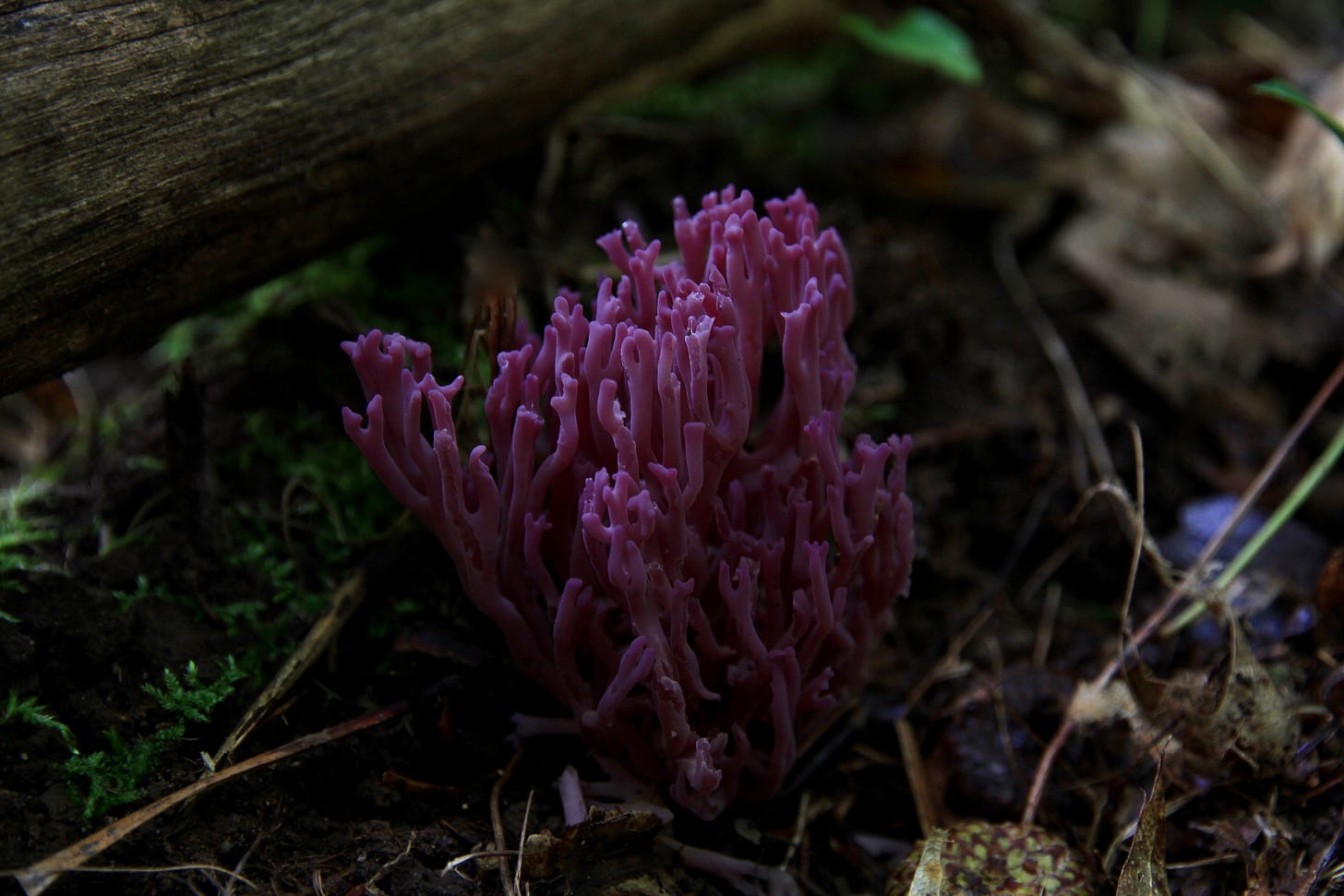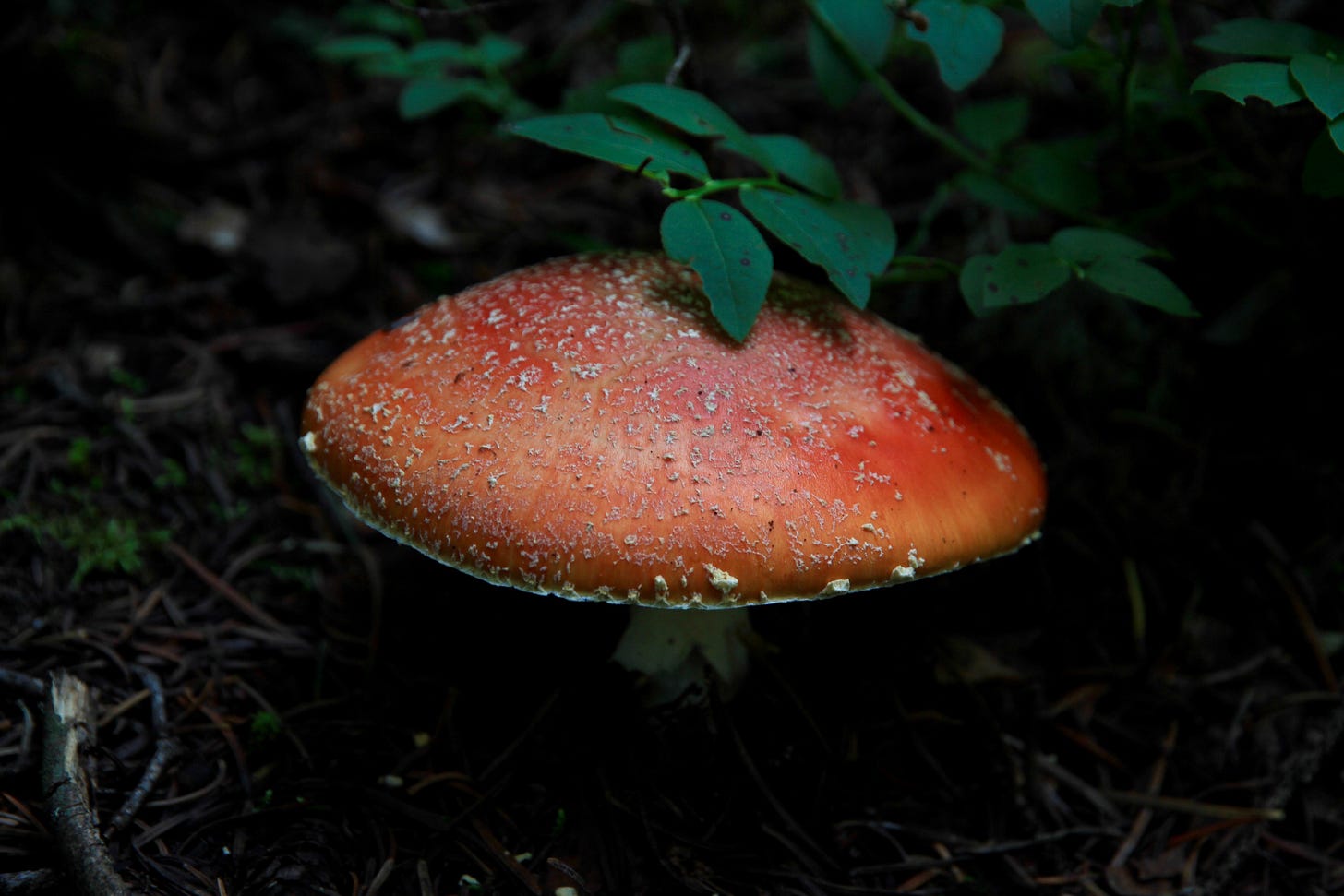Fungi & Deep Imagination
Fungi resonate deep in our psyches as archetypal inhabitants of dual worlds: seen and unseen. Dancing with the fungus is about allowing ourselves to experience the alchemy of the Earth.
I’m excited to get back into leading Deep Imagination Mushroom Walks, something I did a few years ago. I love a good “standard” mushroom walk (if that exists). Observing nature through centering fungi awakens our senses, but my heart also yearns for participating with terrains sacred and imaginal.
Fungi are powerful at igniting a sense of magic, wonder, imagination, curiosity, and awe for children and adults alike. Mushrooms are ephemeral, whimsical bodies passing between our view and something below. What is it about them? Why are they so beautiful? Atrocious? Stinky? Textured? Colorful? Who are they? Not many of us even grow up learning about who these beings are and what they tend to. Out of which the mushroom grows, mycelium, is a network that is more verb than noun. Mycelium is the most common fungal habit, a dynamic, ever-flowing process. Mycelium is a different kind of body — a way of life that changes our human imaginations.
Mycelium is a different kind of body — a way of life that changes our human imaginations.
Mycelium is an intricate network of filaments called hyphae (Greek for “web”). Hyphae are tubular threads that can grow indefinitely under the right conditions and that are 5 times thinner than the average human hair. The functions of mycelium can be oversimplified to absorb nutrients, transport nutrients, and trap structures like nematodes. Individual strands branch and fuse, connect back with one another over and over again, braiding stories unseen. Unseen to whom?
Mycelial coordination is one of dispersed awareness. Mycelium is exploratory, reinforcing growth in the direction of food. Fungus has a directional memory and can regrow again in the same direction as where it previously gathered nourishment. The mycelium of some species is electrically excitable and conducts waves of electrical activity analogous to the electrical impulses in animal nerve cells. Does information travel through mycelium via electrical impulses, cues from changes of pressure or flow, or synchronous metabolic activity? Scientists don’t have one answer and have observed evidence of all three.
Some fungi can detect light levels as low as that provided from a single star (studied by the Nobel Laureate Max Delbruck in the 1950s). The Phycomyces genus has shown an ability to detect objects within 2 mm and can bend away from the objects after about 2 minutes. Paying attention to fungi begins to alter our collections of definitions and habitual perceptions. Mycelium as a body expands our once simple-to-determine definition of a body. Can you see the fungus in you? What about the way that neuro-imaging illuminates neural pathways and synapses through cellular activity, and it often looks much like mycelium. How does the “fungus in you” (there is of course actually lots of fungus in you, but this is for a different time) help you sense your animalness? Fungi are a way of life that can shift our human imaginations.
During my Deep Imagination Mushroom Walks we spend time with the wildness of the soul-based teachings that arise from fungi. What does it mean to digest, sporulate, germinate, decompose, and translocate nutrients? Fungi invite us to question the quality of our embodiment — the quality of our “fruiting body-ness”. Mushrooms themselves provoke all of our senses and often we smell them before we even see them. I like to think they’re making us aware of their biofield, their energetic, sporulating expanse that’s much larger than their flesh alone.
The mushroom that we are lucky enough to encounter reflects a complex fusion of interactions with other organisms and the physical environment over time: temperature, moisture, soil, pH, soil nutrients, vegetation to name a few. Sensing a mushroom can bring us out of our cerebral existence, perhaps once we get over the “What is this?” disposition. Often when we’re outside reveling in mushrooms, the compulsion to know who this being is quickly arises. “What is it?” “Can we eat it?,” often follows. Our urge to know the other-than-human beings around us is actually beautifully immense in my experience leading mushroom walks. People are hungry for knowledge about the Earth. But what good does it do to tell a fungus-newbie 40 names (Latin or common) in their mushroom walk and waltz from one mushroom to the next? What is the goal? To sputter words into a dizzying frenzy that overstimulates the forces of the brain, or to allow people to connect with the aliveness of themselves and that of the Earth?
Allowing our bodies to experience the existence of another being (outright an other-than-human one) is explicitly more powerful, important, and medicinal. People will find a mushroom and without taking a single breath, immediately turn to me to ask , “What is it?”. Not even taking into consideration what they’re experiencing about the mushroom. Where is it living? What odor are you smelling? How does the texture of the warted cap feel on your fingertips? What colors are you seeing? What are the shapes that dance through the body of the mushroom? There is a compulsion to know with the brain.
“Seeing is forgetting the name of the thing one sees”. If a name or a label is the cornerstone of our understanding of the being, we will not see the being for who they are. Frequently attributed to French poet Paul Valéry, this quote has arisen in many of my mushroom walks for over 8 years. The next time you find a mushroom, drop your brain into your heart. What do you notice? Again, I will ask, how do we enhance the kinship between our animal body and the animate terrain? What would happen if we acted as full-bodied creatures and not a disembodied mind?
“Seeing is forgetting the name of the thing one sees.”
We’ve inherited ways of speaking and perceiving that actually upset, fracture, or inhibit this instinctive rapport between our animal senses and the Earth. In another illustration, I invite you to use the word Kindom instead of Kingdom. The Earth is intrinsically alive. Fungi are our kin. Fungi are profound guides, ancestors, teachers, and wise elders who can help us wake up our bodily senses. I believe one of their most timely and powerful medicines presences our bodily senses, what is usually unseen or unfelt.
Fungi have been these allusive beings, poorly understood to many, yet deeply known by others throughout time on this planet. Fungi exist mostly as their mycelium, and only fruiting mushrooms when conditions are just right. Most fungal species don’t even fruit mushrooms. Fungi exist as a metabolizing process: inside, below, beneath, within, and transforming matter. This often unseen process increases plant and animal diversity, builds soil porosity and structure, sequesters up to 1/3 of the carbon in the environment, and performs 90% of marine and terrestrial decomposition. That’s a lot that’s happening beneath the surface.
Fungi have been referred to as “half alive", “somewhere between mineral and plant”, in ancient Arabian texts, “existing between animals and inanimate states”, by 16th century herbalists, and “food of the gods”, “celestial food”, or “flesh of the gods” in the Papyrus Ani, aka Tibetan Book of the Dead. We know through archaeological evidence of the burial site of La Dama Roja de El Mirón on the Iberian Peninsula in present day Spain that for at least 18,500 years humans have been ingesting mushrooms for some reason.
It has been shown that 3,623 years ago, the Eleusenian Mysteries were being annually celebrated in Eleusis, Greece. This was an annual ritual festival for the Cult of Demeter and Persephone in which likely an entheogen was mixed of ergot and psilocybe, amanita, or poppy was ingested. In present day Guatemala, Mexico, and El Salvador, around 300 mushroom shaped stones have been found from 3,000 years ago. From Maya Highland language dictionaries compiled after Spanish conquest, there are words for xibalbaj okox, meaning “underworld mushroom”, and k’aiwhia okox meaning “the mushroom that makes one lose one’s judgment”. From the Aztecs, who called mushrooms “God’s flesh”, and whose culture flourished throughout the 1300s and 1400s, to the Mazatecs and Olmecs, and then the Selkup, Khanty, Tungus people in present day Siberia wherein the word “Shaman” is derived. From the Tungus people, the Shaman is traced to the Amanita communing people and can be translated to mean “diviner”, “magician”, “doctor”, “creator of ecstasy”, and “mediator between the human and supernatural or spirit worlds”.
Whether we learn about how humans have befriended fungi over time (or did fungi befriend us?), or if we simply observe fungi in our terrains, we can see a clear message. Fungi resonate deep in our psyches as archetypal inhabitants of dual worlds: realms above and below. Much like the Raven, or other medicines of Earth who speak for the in-between, when the fungus appears, it offers the opportunity to go beyond what you know or what you think you know. Dancing with the fungus is about allowing ourselves to experience the sensations of our body and thereby experience the alchemy that lives in all nature. We often treat the invisible as empty space, a convenient dumpsite for toxins, but it is alive and sacred! Fungi help us experience that the unseen is medicinal and pulsing with life. Thank you, fungi, for helping us dance between worlds.





Going into the woods now!
Amazing, thank you